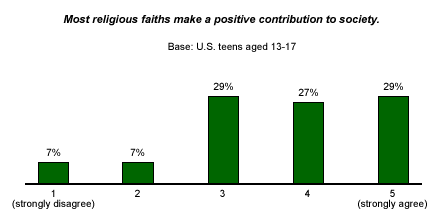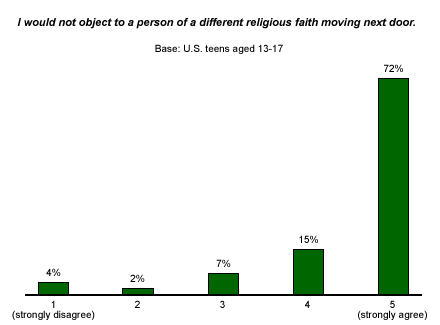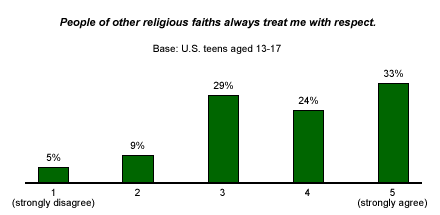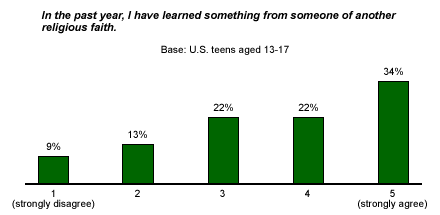This is the second in a two-part series. The first article took an initial look at recent teen responses to the Â鶹´«Ã½AV Religious Tolerance Index survey (see Teens and Religious Tolerance: Part I in Related Items).
Â鶹´«Ã½AV's Religious Tolerance Index consists of five questions designed to place respondents along a scale of isolated, tolerant, and integrated attitudes. Data from an initial analysis of the nation's 13- to 17-year-olds* indicate that about 24% of America's teens are isolated in their attitudes toward others of different faiths, 50% are tolerant, and 27% are integrated.
Now let's take a closer look at teens' answers to each of the five individual items that make up the Index. For each item, teens were given a statement and asked to rate their level of agreement on a scale of 1 to 5, with 1 being "strongly disagree," and 5 being "strongly agree."
Item One: I always treat people of other religious faiths with respect.
The first item addresses a factor fundamental to understanding anyone who is different from oneself -- respect. More than four in five teens (81%) respond with a 4 (20%) or a 5 (61%), indicating a majority believe that they treat people of different religious faiths with respect.

Item Two: Most religious faiths make a positive contribution to society.
There is a difference between respecting other's traditions and believing that those traditions make a positive contribution to society, and responses to this item reflect that difference. America's youth are more divided here: Only 29% of those surveyed gave this item a 5 (strongly agree), 27% gave it a 4, and 29% gave it a 3.
A number of influences may contribute to teen ambivalence. Some may not feel they know enough about other faiths to judge whether they make a positive contribution; others may be reacting to the brand of fanatical Islam espoused by Osama bin Laden; for others, the question may call forth the sometimes negative portrayal of conservative Christians by the popular media.

Item Three: I would not object to a person of a different religious faith moving next door.
This is where the Index starts to bring the issue of religious tolerance into the realm of the everyday: How do you feel about those in close proximity practicing a different faith from the one you practice? The answer for a solid majority of teens is, "just fine, thank you" -- 72% "strongly agree" that they would not object, while another 15% give a 4, indicating more moderate agreement.

Item Four: People of other religious faiths always treat me with respect.
This item turns the first item on its head. In addition to finding out how respondents think they treat others, we're interested in finding out how they feel they are treated by others. Religiously integrated individuals are more likely to perceive that they are treated respectfully by others of a different faith than are tolerant or isolated individuals. As a whole, teens are far less certain that they're respected when it comes to their faith than they are that they respect others. Only a third of teens (33%) gave this item a 5 ("strongly agree"), while 24% gave it a 4 and 29% a 3.

Item Five: In the past year, I have learned something from someone of another religious faith.
This item addresses the degree of interaction between those of different religious faiths. By definition, religiously integrated individuals tend to look for opportunities to interact with and learn from others whose faith is different from their own, while tolerant and isolated individuals do not. Among teens generally, 34% "strongly agree" with this item, while 9% "strongly disagree." Twenty-two percent rate this item a 4, and 22% rate this a 3, which suggests that teens see fewer opportunities to interact with people of different faiths than do adults, who tend to be significantly more likely to respond with a 4 or 5 to this question.

Bottom Line
A solid majority of American teens are tolerant or integrated in their attitudes toward others of different religious faiths -- adopting at the very least a "live-and-let-live" approach.
But a closer look at the items measuring tolerance show that the basis for that attitude is more self-centered than other-centered: The items with the highest percentage of "strongly agree" responses relate to the participants' views of their own attitudes toward others, while the lowest percentage of "strongly agree" responses relate to interactions with others. Improving the level of tolerance and integration among teens may well be more dependent on increasing opportunities to interact with -- rather than learn about -- people of different religions and cultures. When it comes to accepting other faiths, like most other things, experience may be the best teacher.
*The Â鶹´«Ã½AV Youth Survey is conducted via an Internet methodology provided by Knowledge Networks, using an online research panel that is designed to be representative of the entire U.S. population. The current questionnaire was completed by 439 respondents, aged 13 to 17, Aug. 8-19, 2004. For results based on the total sample, one can say with 95% confidence that the maximum margin of sampling error is ±5 percentage points.
